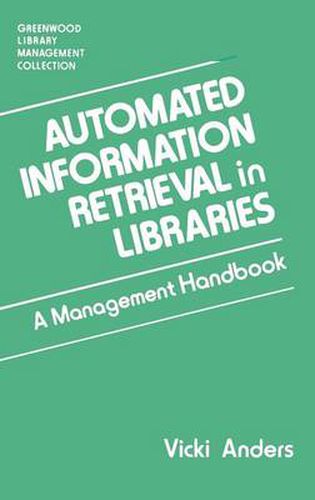Readings Newsletter
Become a Readings Member to make your shopping experience even easier.
Sign in or sign up for free!
You’re not far away from qualifying for FREE standard shipping within Australia
You’ve qualified for FREE standard shipping within Australia
The cart is loading…






Computerized database searching is a common phenomenon in libraries today. Everyone does it, but not everyone does it well, especially when so many options for computerized searching are available. This is not a book about how to search ; rather, it is a book about how to integrate computerized database searching into the fabric of library operations. Managers of automated information retrieval services may find practical advice and suggestions for planning for the future. The first chapter details how to make the options work together, how locally-loaded databases and CD-ROM databases impact on traditional mediated searches, and how end-users affect the librarian-as-search-analyst role. Managing and budgeting for an integrated service are covered in detail in chapters of interest to library managers planning to institute or expand a search service or to managers of existing search services. The special problems of library staff who serve as search analysts, and the special problems of end-users and how they interact with, and how they understand the concept of database searching are discussed in sections dealing with the human side of working with automated information retrieval. The author discusses the hardware and software of searching and the effect of the continuing rapid development of technology on the budget and the future role of libraries. Selected bibliographies direct readers to case studies and articles examining practical experiences of various libraries.
$9.00 standard shipping within Australia
FREE standard shipping within Australia for orders over $100.00
Express & International shipping calculated at checkout
Computerized database searching is a common phenomenon in libraries today. Everyone does it, but not everyone does it well, especially when so many options for computerized searching are available. This is not a book about how to search ; rather, it is a book about how to integrate computerized database searching into the fabric of library operations. Managers of automated information retrieval services may find practical advice and suggestions for planning for the future. The first chapter details how to make the options work together, how locally-loaded databases and CD-ROM databases impact on traditional mediated searches, and how end-users affect the librarian-as-search-analyst role. Managing and budgeting for an integrated service are covered in detail in chapters of interest to library managers planning to institute or expand a search service or to managers of existing search services. The special problems of library staff who serve as search analysts, and the special problems of end-users and how they interact with, and how they understand the concept of database searching are discussed in sections dealing with the human side of working with automated information retrieval. The author discusses the hardware and software of searching and the effect of the continuing rapid development of technology on the budget and the future role of libraries. Selected bibliographies direct readers to case studies and articles examining practical experiences of various libraries.